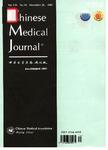Engaging HIV-infected patients in antiretroviral therapy services: CD4 cell count testing after HIV diagnosis from 2005 to 2009 in Yunnan and Guangxi, China
Engaging HIV-infected patients in antiretroviral therapy services: CD4 cell count testing after HIV diagnosis from 2005 to 2009 in Yunnan and Guangxi, China作者机构:Division of Treatment and Care National Center for AIDS/STD Control and Prevention Chinese Center for Diseases Control and Prevention Beijing 100050 China Yunnan Center for Diseases Control and Prevention Kunrning Yunnan 650022 China Yunnan AIDS Care Center Ktmming Yunnan 650118 China Division of HIV and Sexually Transmitted Disease Guangxi Center of Diseases Control and Prevention Nanning Guangxi 530012 China Outpatient Clinic Provincial Center of Diseases Control and Prevention Nanning Guangxi 530000 China Harvard Medical School Boston USA The Office of Global Research National Institute of Allergy and Infectious Diseases US National Institutes of Health Beijing 100600 China Beijing Ditan Hospital Affiliated to Capital Medical University Beijing 100015 China
出 版 物:《Chinese Medical Journal》 (中华医学杂志(英文版))
年 卷 期:2011年第124卷第10期
页 面:1488-1492页
核心收录:
学科分类:01[哲学] 0101[哲学-哲学] 1002[医学-临床医学] 08[工学] 0839[工学-网络空间安全] 010108[哲学-科学技术哲学] 081201[工学-计算机系统结构] 0812[工学-计算机科学与技术(可授工学、理学学位)]
基 金:This study was supported by the grant from the Chinese National Basic Research Program (973
主 题:human immunodeficiency virus CD4 cell count testing care linkage risk factors
摘 要:Background The initiation and expansion of China's national free antiretroviral therapy program has led to significant improvement of survival among its participants. Success of further scaling up treatment coverage rests upon intensifying HIV screening and efficient linkage of care. Timely CD4 cell count testing after HIV diagnosis is necessary to determine whether a patient meets criteria for antiretroviral treatment, and represents a crucial link to engage HIV-infected patients in appropriate care, which has not been evaluated in *** We evaluated all patients ≥16 years who tested HIV positive from 2005 to 2009 in Yunnan and *** Logistic regression models were applied to identify factors associated with lack of CD4 cell count testing within 6 months after HIV *** A total of 83 556 patients were included. Over the study period, 30 635 (37%) of subjects received a CD4 cell count within 6 months of receiving the HIV diagnosis. The rate of CD4 cell count testing within 6 months of HIV diagnosis increased significantly from 7% in 2005 to 62% in 2009. Besides the earlier years of HIV diagnosis, negative predictors for CD4 cell count testing in multivariate analyses included older age, not married or unclear marriage status,incarceration, diagnosis at sexual transmitted disease clinics, mode of HIV transmission classified as men who have sex with men, intravenous drug users or transmission route unclear, while minority ethnicity, receipt of high school or higher education, diagnosis at voluntary counseling and testing clinics, and having HIV positive parents were *** Significant progress has been made in increasing CD4 testing among newly diagnosed HIV positive patients in Yunnan and Guangxi from 2005-2009. However, a sizable proportion of HIV positive patients still lack CD4testing within 6 months of diagnosis. Improving CD4 testing, particularly among patients with identified risk factors, is essential to link



